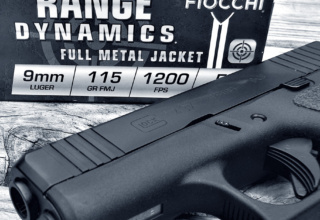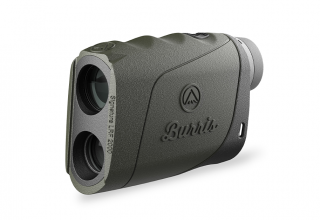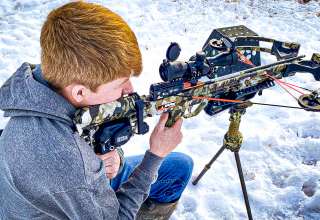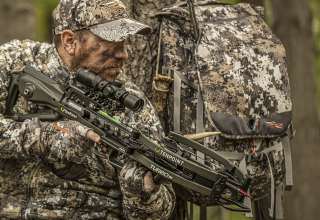Weighing the pros and cons of bow sight options
by Tracy Breen
Several years ago, a few friends and I headed to Kansas to bowhunt whitetails. All of us had camera guys over our shoulders to film the hunts for Mathews TV. I remember one very accomplished hunter on the trip completely missed a monster buck because he was caught up in the moment when he came to full draw and forgot to adjust his single-pin sight to the proper yardage for the shot. The buck moved several times before the hunter took the shot and he simply forgot about the small detail of adjusting his sight when the buck moved a few yards closer from where he originally ranged him with a rangefinder. The moment the arrow left the string, he remembered the mistake. He vowed that day that he would no longer use a one-pin sight.
About a year after that whitetail hunt, I arrowed a nice bull elk in New Mexico with a one-pin TRUGLO sight on my bow. Moments before I let the arrow fly, I ranged the bull with my rangefinder, adjusted my sight accordingly, and shot. The hit was perfect, and the bull went down within sight. I ended up using that one-pin sight for many years.
This doesn’t mean a one-pin sight is perfect for everyone. A multi-pin sight can be awesome. Here, we’ll break down the pros and cons of each.
Single-Pin Advantages
One great single-pin sight is the TRUGLO Range Rover Pro. What most bowhunters, including myself, enjoy most about a single-pin sight is with only one pin to focus on when aiming, the archer has a very large field of view, which makes acquiring a target much simpler than it is with a multi-pin sight. Some bowhunters complain of pin confusion when they use a multi-pin sight—especially in the heat of the moment when a deer or other big game animal is standing in front of them. With a single-pin sight, a bowhunter can easily settle the pin on the target and make sure the pin is precisely where they want to aim.
The Yardage Dial
Another reason many bowhunters like single-pin sights is because they have a yardage dial that makes adjusting the sight to accurately shoot a wide variety of different yardages a piece of cake. The TRUGLO Range Rover Pro comes with zero-in yardage tapes, allowing the bowhunter to attach the proper tape to the sight that fits their arrow trajectory across the effective shooting range from 20 to 80 yards. Having a sight that allows the bowhunter to be dialed in yard by yard out to 80 yards is another reason bowhunters love single-pin sights. They are pin-point accurate.
Let There be Light
Single-pin sights are known to be extremely bright. The TRUGLO Range Rover Pro surely is. What makes this sight so unique is the fact that it uses PWR•DOT technology, which is an LED illumination system inside the lens instead of a conventional pin. The illuminated dot has 11 brightness settings so the dot can be easily adjusted in low light conditions. The Range Rover Pro also comes with a black reference circle on the perimeter of the sight housing. This makes centering the sight dot in the middle of a peep sight quick and easy.
Multi-Pin Advantages
There is no doubt that single-pin sights have their place in the woods, but many bowhunters prefer using multi-pin sights. Bow sights including the Storm G2 from TRUGLO is an example of an economical multi-pin sight that is a great choice for bowhunters. Sights such as the G2 are available in a 3- or 5-pin option and are built with extra bright .019 fiber optic pins. Multi-pin sights come with pins that are several colors so the bowhunter can easily distinguish between their 10- and 20-yard pin or their 20- and 30-yard pin.
The greatest advantage of a multi-pin bow sight is the bowhunter never has to worry about adjusting the bow sight during the hunt. With a multi-pin sight, the archer just uses the pin that coincides with the distance to the target. Sometimes aiming a little low or high is a must but for the most part, once a multi-pin sight is dialed in, the sight can be aimed and the arrow released with confidence.
Most deer hunters who are taking shots at 20 or 30 yards will be fine using a 3-pin sight. Bowhunters who want to have more yardage options will prefer a 5-pin sight so they can have pins in 5-yard increments, not just 10-yard increments. The advantage of a 3-pin sight is there is a large field of view when using a 3-pin sight. A 5-pin sight doesn’t have as big of a field of view. A 5-pin sight means you can also set your yardages out to 50 yards (10, 20, 30, 40, and 50 yards) or 60 yards (20, 30, 40, 50, and 60 yards).
At the end of the day, it all boils down to personal preference. Both single-pin and multi-pin sights have their place in the woods. Regardless of the type of sight a bowhunter chooses, making sure to buy one with bowhunter-friendly features is a must. Sights that have a lighted pin option, a sight that can be used by left- or right-handed shooters, and a sight that is extremely durable is a must. Many brands, including TRUGLO, come with these options. Of course, choosing a sight that has the above options and doesn’t break the bank is also a must.
Over the years I have bowhunted with single-pin and multi-pin sights and I enjoy using them both. Trying both options for yourself is probably the best way to determine which option is best for you.
- Single- vs Multi-Pin Sights - October 29, 2020
- Cash in on Early-Season Scrapes - September 21, 2020
- Scent Elimination Strategies EVERY Hunter Needs to Know - September 2, 2020




















